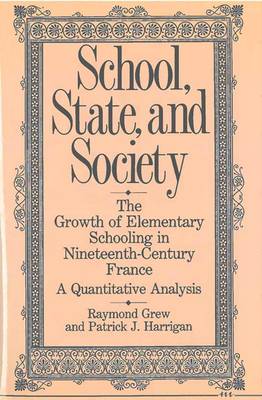
- Afhalen na 1 uur in een winkel met voorraad
- Gratis thuislevering in België vanaf € 30
- Ruim aanbod met 7 miljoen producten
- Afhalen na 1 uur in een winkel met voorraad
- Gratis thuislevering in België vanaf € 30
- Ruim aanbod met 7 miljoen producten
Zoeken
School, State, and Society
The Growth of Elementary Schooling in Nineteenth-Century France--A Quantitative Analysis
Raymond Grew, Patrick J Harrigan
Hardcover | Engels
€ 135,95
+ 271 punten
Omschrijving
School, State, and Society is a comprehensive analysis of French elementary education in the nineteenth century. It begins in the decades before the Guizot law of 1833, which made the establishment of public schools in every commune France's national policy, and continues to 1906, just after Church and state were formally separated and Catholic schools officially abolished. Grew and Harrigan base their study on the vast amount of statistical information that was systematically collected in France beginning in the 1830s. This information was put into machine-readable form for computer analysis. School, State, and Society examines several important aspects of elementary schools in France in the nineteenth century: the availability of schooling; enrollment; different types of schools (Catholic and lay, public and private); schooling for girls versus schooling for boys; elementary teachers' the elementary school as an institution and the links between elementary education and further instruction; and budgets and expenditures. The analysis revises some standard interpretations of the role of Catholic schools and of a nationally centralized system. The picture that emerges challenges some common impressions - among them that schooling in France progressed slowly and late, that it had to overcome great local resistance, and that the enrollment of girls long lagged behind that of boys.
Specificaties
Betrokkenen
- Auteur(s):
- Uitgeverij:
Inhoud
- Aantal bladzijden:
- 336
- Taal:
- Engels
Eigenschappen
- Productcode (EAN):
- 9780472100958
- Verschijningsdatum:
- 24/01/1992
- Uitvoering:
- Hardcover
- Formaat:
- Genaaid
- Afmetingen:
- 160 mm x 234 mm
- Gewicht:
- 635 g

Alleen bij Standaard Boekhandel
+ 271 punten op je klantenkaart van Standaard Boekhandel
Beoordelingen
We publiceren alleen reviews die voldoen aan de voorwaarden voor reviews. Bekijk onze voorwaarden voor reviews.








